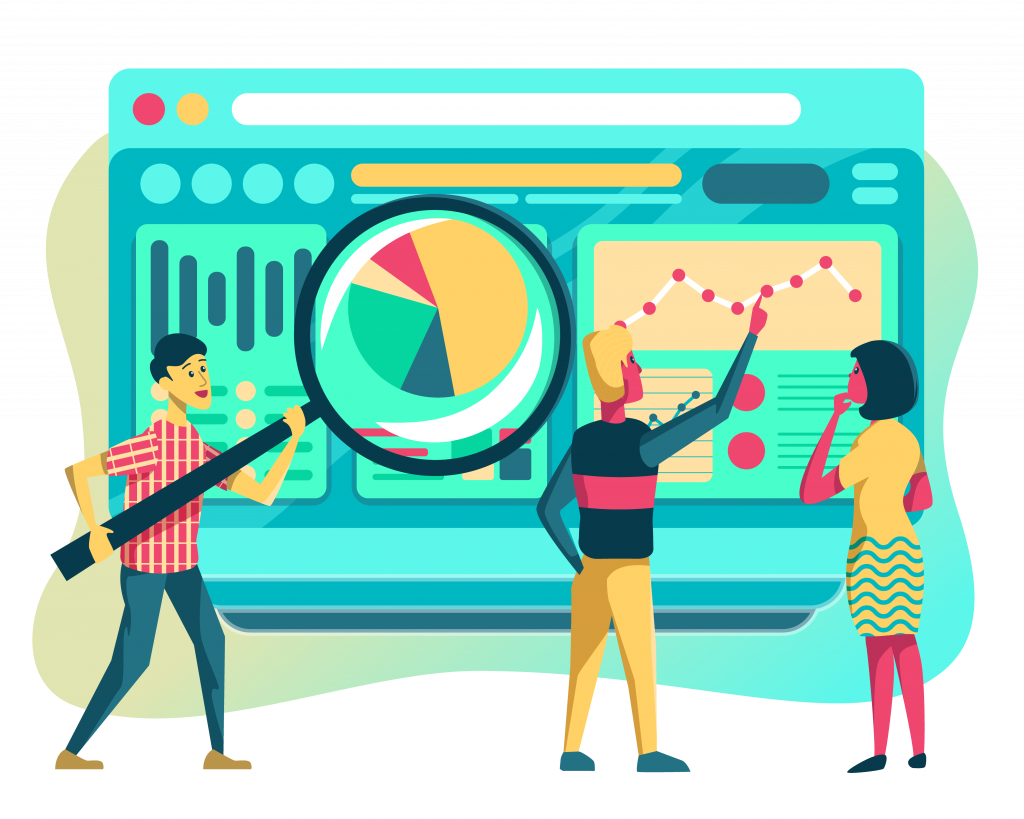This article will explore the importance of web analytics, the roles & functions of data analytics, and how it can help you analyse your business goals.
When determining what measurements to track, there are a few things that you should consider:
-What is the goal of my company?
-How do I measure success?
-What does my customer want from me?
-What are the main areas of my business?
-What does my competition do?

The questions mentioned above will help you to determine what is important for your business. It would be best to keep in mind the main thing is the customer and how they look at your website. Some examples of common metrics include the number of visits, bounce rates, pages per visit, average time spent on the page by visitors from each source/medium etc.
Note that the examples mentioned above are just some of many. You can use web analytics to measure almost anything you want!
-Which areas do I need to improve on?
-What is working well for us?
-Are there any new marketing campaigns or sources we should look into further?
The main reason why most companies rely so heavily on web analytics is that it helps them see where their business stands and what they need to fix if necessary.
Digital Marketing Analytics:
Digital Marketing Analytics is the data collected from the digital platforms that help marketers evaluate their marketing initiatives’ performance. Marketing Analytics also helps to understand the current situation, weaknesses and opportunities of the business. With the analytics data, marketers can refer back to the previous strategies, compare them with the current ones, and make better results.
Marketing Analytics is the backbone of every business; spending the marketing budget without analysing this data will see no return on investment.
Roles of Digital Marketing Analytics:
Data analytics are often referred to as tools or platforms used to collect and analyse online marketing activity data. Analytics are tools used to make sense of the data by customising the dashboard and reporting options to accurately surface the vital information for the business and web properties using individual analytics from social network channels such as Facebook and Twitter. Once all the marketing data is brought together, the analytics tools can turn data into insights. However, if the platforms are stacking up data without context or insight, the analysis might take some time or might need help from the IT specialist or a data scientist. The goal is to produce insights that can help better understand customers and their thought processes and align with their wants and needs.
Digital Analytics help companies to identify opportunities and risks, Performance against marketing objectives, and Accountability to justify Return on Investment (ROI).
1. Opportunities and Risk
Data analytics allows marketers to understand the immediate and long-term effects of the marketing strategy against the competition. The customer becomes the central part of planning with data analytics, building a more solid relationship with individual audience members and building loyalty. Analytics tools help gain access to a great deal of information that will benefit companies, and the information can be used to ask their audience about the types of products and services they want and need. The risk involved is less when there is information available about the market beforehand.
For example, Bounce rate – Bounce rate is a measure of quality and engagement on the website. It signifies the percentage of users viewing only one page upon entering the site. If the site’s bounce rate is high, this could indicate a lack of relevant content for the customer base that the brand is trying to attract. Alternatively, it might mean that the brand is not attracting the right target audience. So, they land on the page, realise the site is not for them, and bounce. Now, there is an opportunity to improve the website content according to the brand’s customer base and avoid the risk of losing customers to the competition.
2. Performance against marketing objectives
Marketing objectives are a brand’s defined goals. They provide clear direction for team members to follow, outline the intentions of the marketing team, and offer information for executives to review. Marketing objectives are a crucial part of a marketing strategy. A brand will achieve its plans with defined goals as it will be clear on what it wants to do. It requires a straightforward plan to know what to do and how to do it.
Once the marketing objectives and goals are set, it is time to figure out how to measure them. A successful goal setting requires placing KPIs, benchmarks, numbers, deadlines, and metrics to each marketing objective. You should be very careful in choosing the right metrics because most of the metrics are vanity metrics – you can read more about vanity metrics in an article from Clicademy. KPIs and marketing metrics allow evaluating progress along the way and assessing results at the end of the campaign. By benchmarking the goals, it will be easier to know from data analytics whether the work was successful.
For example, If the objective is to increase Total site visits – it gives an idea of how effective the campaigns are at driving traffic. The visits should grow steadily over time; if it drops month to month, it is time to take a hard look at marketing channels to identify the problem.
3. Accountability to justify ROI
Data is the lifeblood of marketing. Numbers show marketing effectiveness. Analytics will reveal the success of all the efforts and justify the steps that have been taken. A marketer should constantly keep an eye on the numbers; they will act as a guide to help marketing campaigns deliver more revenue.
Marketing accountability requires determining how to measure, track and report – value, contribution and impact to the business. A marketing plan should always be based on specific and actionable business goals to drive meaningful ROI.
For example, a lead generation campaign is set to acquire 100 leads in 2days by spending £100. The campaign’s effectiveness can be measured by comparing the cost of acquiring leads against the revenue generated by converting the leads.
Functions of Digital Marketing Analytics:
There are four levels of data analysis.
1. Descriptive Analytics:
This is the first and most common level and provides an answer to the question “What happened?”. Descriptive analytics is the study of historical data to understand changes/advances in a business that have occurred. Descriptive analytics also helps draw comparisons from the range of historical data. For example, the metrics included in descriptive analytics are the total revenue per subscriber, month-over-month sales growth, the number of users, and year-over-year pricing changes.
2. Diagnostic Analytics:
Diagnostic analytics is a kind of advanced analytics that analyses data/content to answer the question, “Why did it happen?”. Assessing the descriptive data further, the analyst can point out and isolate the root cause of the problem with diagnostic analytics tools. Diagnostic analytics is also called the root cause analysis.
3. Predictive Analytics:
This is all about forecasting, “What is likely to happen?”. Predictive analytics applies a variety of variable data to make predictions. For example, based on the patterns in data collected by the government during the pandemic, predictive analytics forecasts the need to vaccinate older people as a priority as they are vulnerable. So age has a linear correlation with COVID risk.
4. Prescriptive Analytics:
“What should the marketer do?”, Based on the forecast from predictive analytics, the marketer can now decide the course of action to take. The prescriptive analysis is not just taking one action; it is a host of actions/responses.
Our expert team will help you set up analytics and provide insights and solutions required to maximise conversions for your business.
References:
- Brinkmann, B. (2019, May 7). Comparing Descriptive, Predictive, Prescriptive, and Diagnostic Analytics. Logi Analytics. https://www.logianalytics.com/predictive-analytics/comparing-descriptive-predictive-prescriptive-and-diagnostic-analytics/
- Farris, P. W., Bendle, N. T., Phillip Edward Pfeifer, & Reibstein, D. J. (2017). Key marketing metrics : the 50+ metrics every manager needs to know. Pearson Education Limited.
- Frankenfield, J. (2020, December 29). How Descriptive Analytics Work. Investopedia. https://www.investopedia.com/terms/d/descriptive-analytics.asp#:~:text=Descriptive%20analytics%20is%20the%20interpretation
- (n.d.). Definition of Diagnostic Analytics – Gartner Information Technology Glossary. Gartner. Retrieved April 1, 2021, from https://www.gartner.com/en/information-technology/glossary/diagnostic-analytics#:~:text=Diagnostic%20analytics%20is%20a%20form
- Kosaka, K. (2018, February). How to Define and Measure Marketing Objectives: A Start-to-Finish Guide. Alexa Blog; Alexa Blog. https://blog.alexa.com/marketing-objectives/
- Maydon, T. (2017). The 4 Types Of Data Analytics. Principa.co.za. https://insights.principa.co.za/4-types-of-data-analytics-descriptive-diagnostic-predictive-prescriptive
- Puente, L., Tindall, E., & Sifuentes, R. (n.d.). How to Build ROI and Accountability into Your Marketing Plan. BrandExtract. Retrieved April 2, 2021, from https://www.brandextract.com/Insights/Articles/How-to-Build-ROI-and-Accountability-into-Your-Marketing-Plan/
- Sponder, M., & Khan, G. F. (2018). Digital analytics for marketing. Routledge.
- Team, D. J. (n.d.). Why is digital marketing analytics important?demandjump.com. Retrieved April 2, 2021, from https://www.demandjump.com/blog/why-is-digital-marketing-analytics-important
- VisionEdge Marketing | Marketing Accountability. (n.d.). VisionEdge Marketing. Retrieved April 2, 2021, from https://visionedgemarketing.com/marketing-accountability/
- Wedel, M., & Kannan, P. K. (2016). Marketing Analytics for Data-Rich Environments. Journal of Marketing, 80(6), 97–121. https://doi.org/10.1509/jm.15.0413
